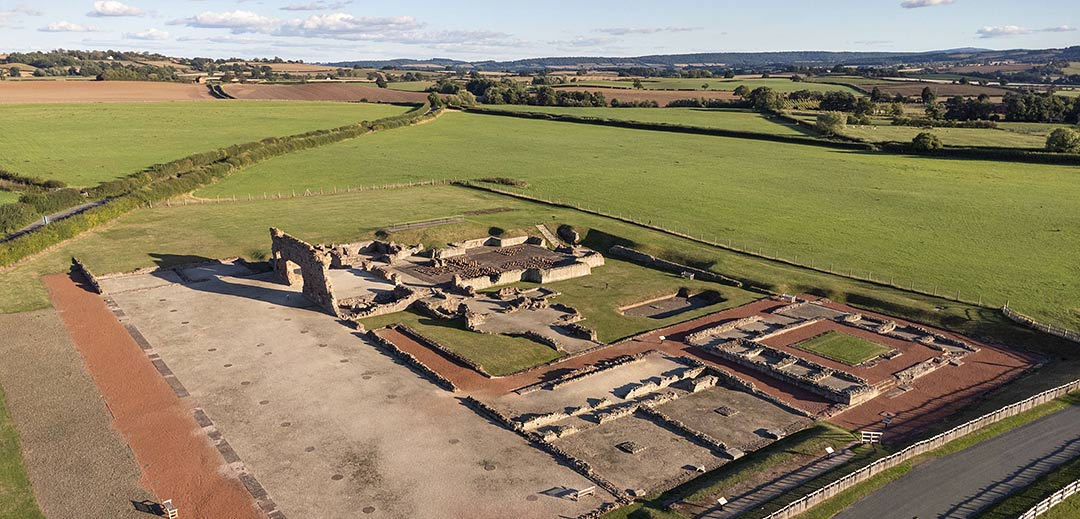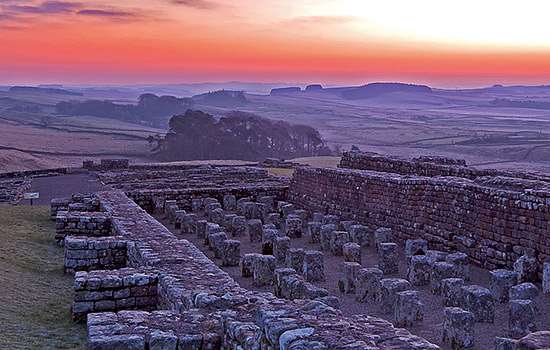Significance of Wroxeter Roman City
Wroxeter is probably the best-preserved Roman city in Britain, as well as one of the largest. It is roughly the same size as Pompeii in Italy, but only a fraction of it can be seen today. Its excellent state of preservation is due to the fact that only small areas of it have been excavated.
The study of Wroxeter allows us to see and appreciate a Roman city in its entirety rather than piecemeal through fragments seen in excavation, as is usually the case in other Roman towns and cities.

State of preservation
When the city was abandoned, probably sometime in the 5th century, the site reverted to the farmland it had once been. Ploughing over the centuries will have damaged the upper levels, but the city remained largely intact until the excavations of the baths from 1859.
This means that unlike many other major Roman towns in Britain, the site is little disturbed, allowing both aerial archaeology and geophysics to reveal much about the whole site. In addition, where excavation has been possible, in the city centre, levels of preservation are very good. This has enabled us to learn something of the city’s economy and trading contacts, through the many artefacts that have been found.
Archaeological investigations
Wroxeter has witnessed, and been part of, the development of archaeology over the last 150 years, as evolving techniques and approaches help us understand the past. From the early days – when excavation of the ruins of the baths was no more than clearance of the strata overlying the remains of the buildings – right through to the science of using technology to see through the soil while leaving the archaeological strata undisturbed, Wroxeter has been among the most innovative and important sites for understanding the archaeology of Roman Britain.
The excavations carried out by JP Bushe-Fox, Inspector of Ancient Monuments, between 1912 and 1914 revealed the story of how Wroxeter’s housing developed, and remains one of the few occasions when the houses of ordinary people in the city have been studied. Bushe-Fox was among the first to realise the importance of everyday Roman pottery in dating a site, and in understanding its economic context.
Before the Second World War, and again just after it, one of Britain’s leading women archaeologists, Dame Kathleen Kenyon, carried out a series of keyhole excavations that established a sound understanding of the development of the Roman city. Her work with Dr Graham Webster of the University of Birmingham, in collaboration with English Heritage and its predecessors, initiated an annual training school for archaeologists on the baths site that helped train a whole generation of archaeologists in complex urban archaeology.
This programme continued to develop through the 1960s, 1970s and 1980s under Graham Webster and his colleague Philip Barker. Their evolving techniques were at the forefront of the development of new and innovative approaches that revolutionised understanding of later Roman Britain and its distinctive archaeology. The innovation continued into the 1990s when the first full geophysical survey of an entire Roman town in Britain, and an extensive survey of the landscape around it, was carried out by a team led by English Heritage, GSB Prospection and the University of Birmingham.[1]
Cultural and artistic impact
Excavations in the mid-Victorian period generated a great deal of excitement and interest, as they coincided with the growth of rail travel and leisure time. Writers like Charles Dickens visited and publicised what they had seen, while the site was marketed by enterprising train companies as ‘Britain’s Pompeii’. Charles Darwin investigated the science behind the burial of the city through investigation of the humble earthworm.[2]
The site’s three surviving visitor’s books record people from all over the world visiting Wroxeter to explore and experience this imposing set of Roman ruins, set in an idyllic countryside. Visitors could buy souvenir guides, photographs and postcards. while for a few pennies they could be guided around the site by the live-in custodian who curated its chaotic museum. He would point out where bodies had been found in the ruins of the baths, and tell lurid stories of how the city was sacked and burnt.[3]
The soil, and even animal bones, from the early excavations had been piled up on the site, which became so overgrown that the ruins developed a melancholy air. This inspired poets such as AE Houseman, Wilfred Owen and Mary Webb, while the local artist Tom Prytherch painted the picturesque ruins and surrounding landscape, and vividly recreated the supposed sacking of the city.[4]
Eventually, the site was acquired by the state and the ruins were tidied up and consolidated. This allowed excavations to properly explore the site’s history and enable its coherent presentation to visitors, while perhaps losing much of its melancholy charm.
Find out more
-

History of Wroxeter Roman City
Founded in the mid 1st century AD, Wroxeter was one of the largest cities in Roman Britain and is exceptionally well preserved.
-

Collection at Wroxeter Roman City
Tens of thousands of objects provide evidence about the lives and beliefs of Wroxeter’s civilian inhabitants from the 2nd to 4th centuries AD.
-

Research on Wroxeter Roman City
Wroxeter’s importance as a major Roman city in Britain underlines the importance of continuing to research its past.
-

EXPLORE ROMAN BRITAIN
Browse our articles on the Romans to discover the impact and legacy of the Roman era on Britain’s landscape, buildings, life and culture.
-

Buy the guidebook
The guidebook provides a full tour of Wroxeter Roman City and explains the complex history of its rise and decline.
-

Download a plan
Download this pdf plan of the baths complex at Wroxeter to see how the buildings developed over time.